We were planning on a pottering sort of quiet day getting to know Tokyo a bit better after yesterday’s hectic transit day and then wandering around a bit dazed through Shinjuku. So much for that!
We head off in the morning for the Kagurazaka neighbourhood, which is an old district full of tiny little alleyways and bars and tea houses. This older area of Tokyo is also a district for geisha though running into them first thing in the morning is unlikely. We took the JR line train to get here and then a wander up the street led us to the Daijingu shrine. It is known to be a lucky place for those seeking romance and observers come here to make offerings, prayers and donations and leave behind cards and knotted paper wishes on special days of observance – like yesterday the 7th of the 7th.
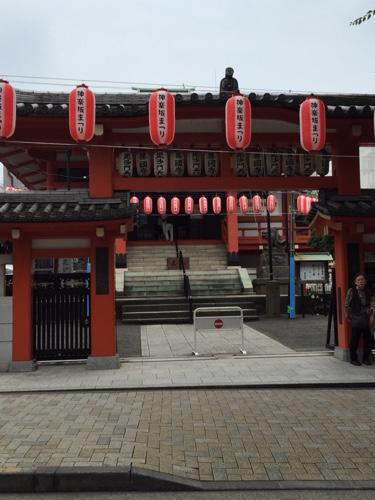
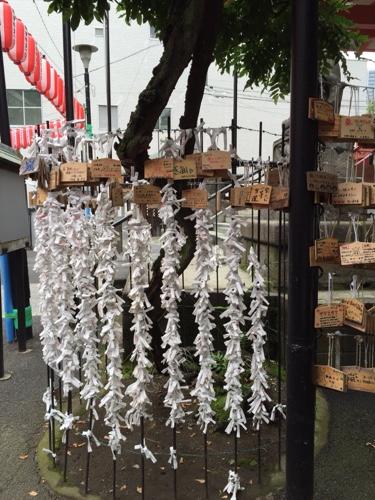


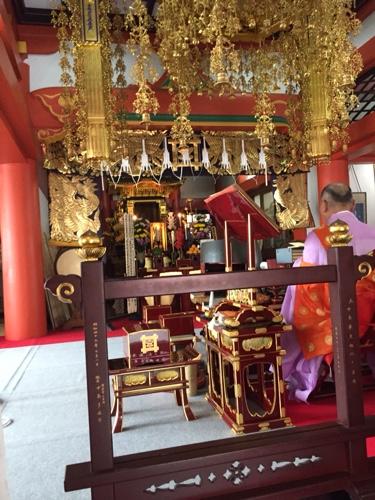 Inside the temple – yes, I know, no photos allowed, but how can I describe this without writing a thousand words? Outside every Shinto shrine is a place where observers can purify themselves before making their offerings. Water is poured on one hand, then the other than to the mouth (usually symbolically these days of micro organism awareness), then water is drawn again and allowed to run over the ladle to clean it for the next person.
Inside the temple – yes, I know, no photos allowed, but how can I describe this without writing a thousand words? Outside every Shinto shrine is a place where observers can purify themselves before making their offerings. Water is poured on one hand, then the other than to the mouth (usually symbolically these days of micro organism awareness), then water is drawn again and allowed to run over the ladle to clean it for the next person. The back alleys of the Kagurazaka district looks exactly like you would expect it to, tiny buildings with little doorways causing entrants to bow deeply upon entering that has been built on over the years. It feels like buildings are not knocked down here to make way for the new, they seem to build by squeezing in among existing buildings or keeping old facades and building upwards behind. It’s very quaint and picturesque. We are planning on coming back here at night to see all the street lanterns lit up and when the bars are overflowing with guests. Saw these massive posts of very messy electrical wiring everywhere in the twisty tiny alleys – I’ve seen much, much worse in places like Romania and Pakistan, but it always makes you worry a little. 🙂
The back alleys of the Kagurazaka district looks exactly like you would expect it to, tiny buildings with little doorways causing entrants to bow deeply upon entering that has been built on over the years. It feels like buildings are not knocked down here to make way for the new, they seem to build by squeezing in among existing buildings or keeping old facades and building upwards behind. It’s very quaint and picturesque. We are planning on coming back here at night to see all the street lanterns lit up and when the bars are overflowing with guests. Saw these massive posts of very messy electrical wiring everywhere in the twisty tiny alleys – I’ve seen much, much worse in places like Romania and Pakistan, but it always makes you worry a little. 🙂 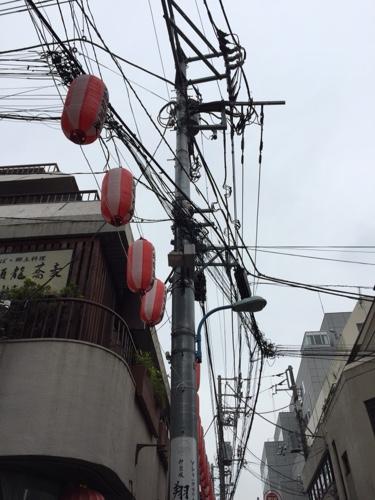
 How could they? *twitch twitch*
How could they? *twitch twitch*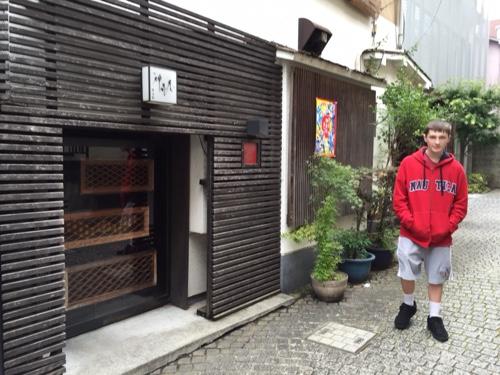 The doorways to all the little bars are just my size, at 5’5″ now though, even Angel would have to duck his head to enter places like these. There are also loads of Italian and French restaurants in the area boasting they’ve been in business for 20 years or more. I never would have expected to see so many restaurants serving European cuisine tucked into one traditionally Japanese tiny neighbourhood – no big chain fast food outlets though, which is kinda cool. Also lots of French patisserie style bakeries selling all the usual croissants and pasteries.
The doorways to all the little bars are just my size, at 5’5″ now though, even Angel would have to duck his head to enter places like these. There are also loads of Italian and French restaurants in the area boasting they’ve been in business for 20 years or more. I never would have expected to see so many restaurants serving European cuisine tucked into one traditionally Japanese tiny neighbourhood – no big chain fast food outlets though, which is kinda cool. Also lots of French patisserie style bakeries selling all the usual croissants and pasteries.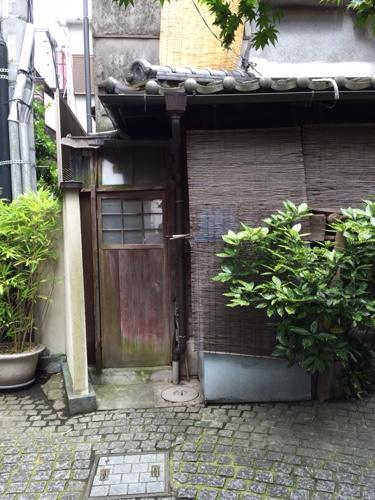
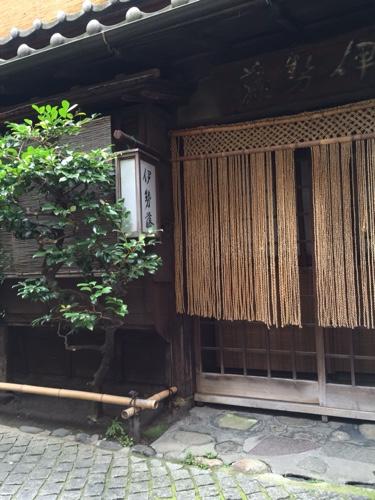
 Never seen such enormous pork buns – these were larger than a grapefruit and about three times the size of what we buy at home – even just one would easily be very filing for lunch. All sorts of flavours and wrapped in plastic… no idea if they were consumed hot or cold, but was just amused at the sheer size of them. We wandered down the street a little, went into a paper shop selling loads of packets of origami paper, another store selling coloured cut glass that looked almost Venetian, and fans galore as well as pairs of highly decorated chopsticks…. and a shoe shop.
Never seen such enormous pork buns – these were larger than a grapefruit and about three times the size of what we buy at home – even just one would easily be very filing for lunch. All sorts of flavours and wrapped in plastic… no idea if they were consumed hot or cold, but was just amused at the sheer size of them. We wandered down the street a little, went into a paper shop selling loads of packets of origami paper, another store selling coloured cut glass that looked almost Venetian, and fans galore as well as pairs of highly decorated chopsticks…. and a shoe shop. 
 After wandering around Kagurazaka for a couple of hours, we head over towards the Yasukuni shrine and the Yushukan War Museum. The war memorial is quite controversial apparently – it clearly celebrates Japan’s lost soldiers, and I don’t use the word ‘celebrate’ lightly… the museum endorses and bolsters the Japanese involvement in WWI and WWII and appears to staunchly support and celebrate the acts of soldiers performed for the good of the Emperor and Empire. Bit hard to explain, but the museum is completely unapologetic for Japan’s involvement in the war. The memorial even honours those hanged for war crimes, go figure. Even the Japanese people themselves disagree with how the government/powers that be are representing these war criminals at the musuem… you see, 80% of Japanese are Shintoist and 70% are Buddhist, which of course adds up to 150% of religiously flexible people. Shinto is all about living a good life, but has no concept of an afterlife, whereas Buddhism is very much interested in living a good life to make it to the next life. So many Japanese ‘Live as a Shintoist and die as a Buddhist’ so they can have the paradise afterlife.
After wandering around Kagurazaka for a couple of hours, we head over towards the Yasukuni shrine and the Yushukan War Museum. The war memorial is quite controversial apparently – it clearly celebrates Japan’s lost soldiers, and I don’t use the word ‘celebrate’ lightly… the museum endorses and bolsters the Japanese involvement in WWI and WWII and appears to staunchly support and celebrate the acts of soldiers performed for the good of the Emperor and Empire. Bit hard to explain, but the museum is completely unapologetic for Japan’s involvement in the war. The memorial even honours those hanged for war crimes, go figure. Even the Japanese people themselves disagree with how the government/powers that be are representing these war criminals at the musuem… you see, 80% of Japanese are Shintoist and 70% are Buddhist, which of course adds up to 150% of religiously flexible people. Shinto is all about living a good life, but has no concept of an afterlife, whereas Buddhism is very much interested in living a good life to make it to the next life. So many Japanese ‘Live as a Shintoist and die as a Buddhist’ so they can have the paradise afterlife.
Shino is a philosophy that embraces nature, ancestor worship and hero worship… and according to Shinto principles, those who live a good life can go one to become gods or dieties after death – hence the Japanese peoples’ strong reaction to those hung as war criminals being honoured as gods or dieties at this musuem and its memorial festivals.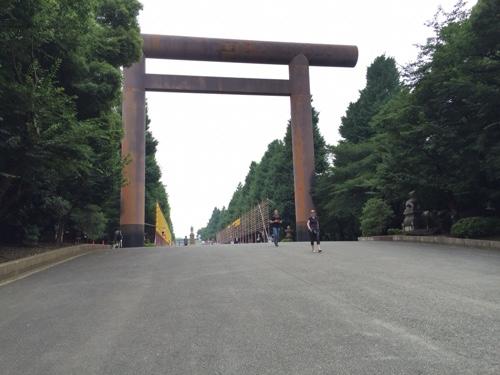 As we made our way down the imposing boulevard – the arch shows the way to the ‘pure’ side of the shrine, leaving the unpure behind – leading up to the Yasukuni shrine which was built in 1882 to honour the now over 2.5 million people Japan has lost in various wars, we saw thousands of lanterns being hung up by a crew of about 20 men, for a festival that starts next week…
As we made our way down the imposing boulevard – the arch shows the way to the ‘pure’ side of the shrine, leaving the unpure behind – leading up to the Yasukuni shrine which was built in 1882 to honour the now over 2.5 million people Japan has lost in various wars, we saw thousands of lanterns being hung up by a crew of about 20 men, for a festival that starts next week…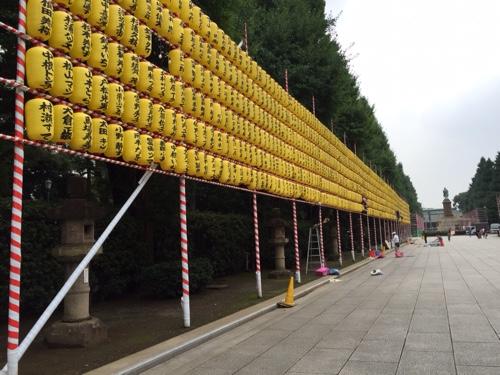
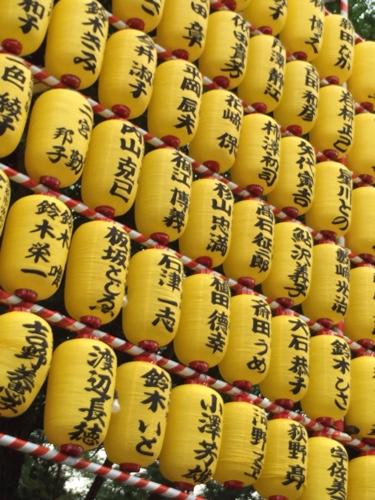 I have discovered that the writing on these lanterns is not as I had expected – names of the honourable dead, but rather they are names of families, companies, restaurants, organizations etc, who have sponsored the festival. So, kinda advertising… which is not as romantic or lofty as what I had originally thought.
I have discovered that the writing on these lanterns is not as I had expected – names of the honourable dead, but rather they are names of families, companies, restaurants, organizations etc, who have sponsored the festival. So, kinda advertising… which is not as romantic or lofty as what I had originally thought.
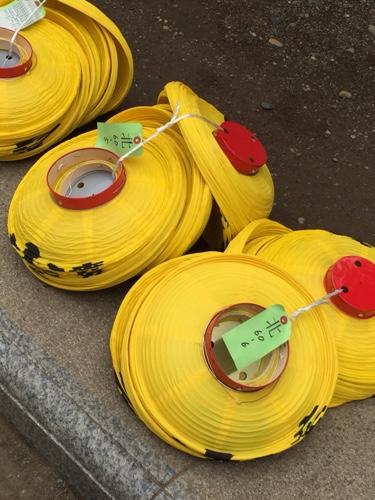
 Festival poster – You never realise just how much easier it is to travel around in English speaking countries, until you head ‘somewhere else’ and are confronted with the inability to read. Anything. The lanterns closer to the shrine are in numbered panels laid out among cherry blossom tress (not currently in bloom) and flocks of white doves live in the park to out number the war hawks; maps display which group are on what panel… each of these little yellow boxes has a light in it and once the festival starts up will look spectacular all lit up. Spectacularly lit up names of companies and sponsors that is.
Festival poster – You never realise just how much easier it is to travel around in English speaking countries, until you head ‘somewhere else’ and are confronted with the inability to read. Anything. The lanterns closer to the shrine are in numbered panels laid out among cherry blossom tress (not currently in bloom) and flocks of white doves live in the park to out number the war hawks; maps display which group are on what panel… each of these little yellow boxes has a light in it and once the festival starts up will look spectacular all lit up. Spectacularly lit up names of companies and sponsors that is. 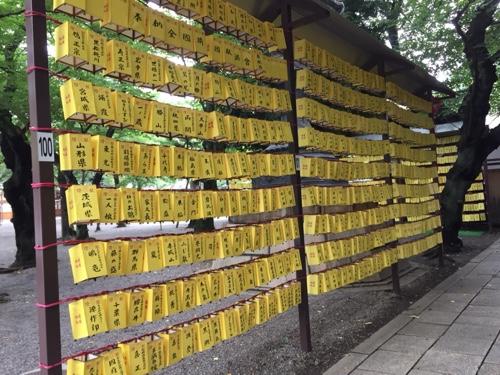
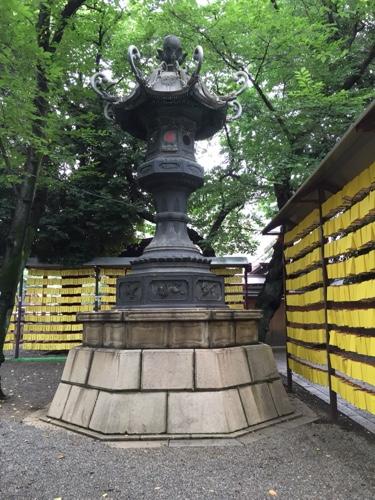
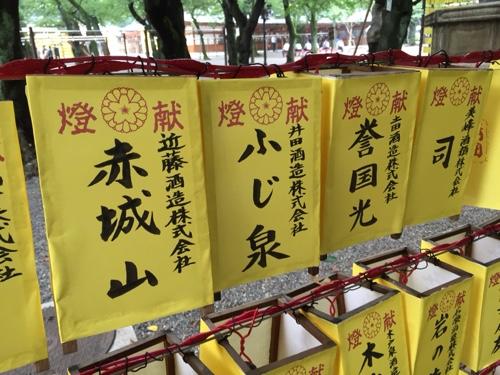 The Kasukuni shrine was built in 1882 and is one of Tokyo’s grandest shrines, attracting lots of visitors. All observers would purify their hands first, then come to the front of the shrine, place an offering in the box (cash offerings even very small coins), bow twice, clap loudly twice to draw the attention of the ancestral dieties, stand with their hands together in silence and make a wish, bow once more time and walk away backwards. As tourists who wanted to get a closer look, without fully knowing the local customs, we walked to the front of the shrine, placed an offering in the box, had a good look around, staring thoughtfully at the building itself wishing we could go inside, before backing out. So, I’ve found a hole in my research – I know the conduct expected when visiting mosques but hadn’t thought to look into the proper etiquette when visiting shrines and temples in Japan. 🙂 I am sure we will figure it out – last thing you want to do is offend by not following customs. (NB: Have been reliably informed that the procedure outlined above is correct and all are welcome to make offerings and wishes at Shinto shrines – it is more a philosphy than a formal religion so the Japanese are not offended by heathen Christians participating which makes a nice change from visiting mosques).
The Kasukuni shrine was built in 1882 and is one of Tokyo’s grandest shrines, attracting lots of visitors. All observers would purify their hands first, then come to the front of the shrine, place an offering in the box (cash offerings even very small coins), bow twice, clap loudly twice to draw the attention of the ancestral dieties, stand with their hands together in silence and make a wish, bow once more time and walk away backwards. As tourists who wanted to get a closer look, without fully knowing the local customs, we walked to the front of the shrine, placed an offering in the box, had a good look around, staring thoughtfully at the building itself wishing we could go inside, before backing out. So, I’ve found a hole in my research – I know the conduct expected when visiting mosques but hadn’t thought to look into the proper etiquette when visiting shrines and temples in Japan. 🙂 I am sure we will figure it out – last thing you want to do is offend by not following customs. (NB: Have been reliably informed that the procedure outlined above is correct and all are welcome to make offerings and wishes at Shinto shrines – it is more a philosphy than a formal religion so the Japanese are not offended by heathen Christians participating which makes a nice change from visiting mosques).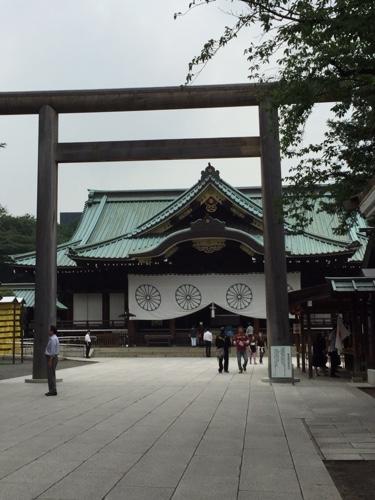
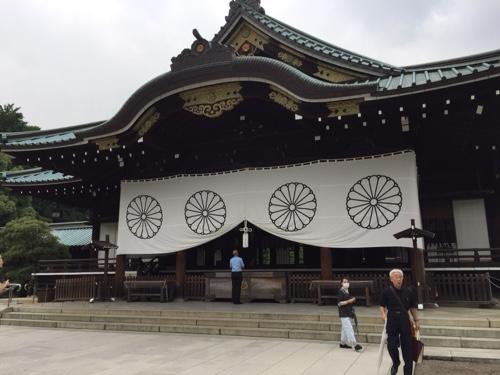
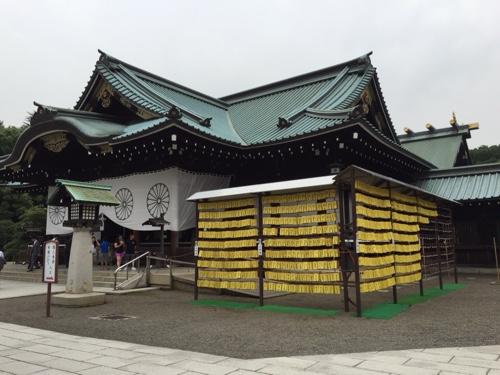 Gorgeous sea monster statuary outside the war memorial, there were also statues commemorating war horses and dogs involvement in wars.
Gorgeous sea monster statuary outside the war memorial, there were also statues commemorating war horses and dogs involvement in wars.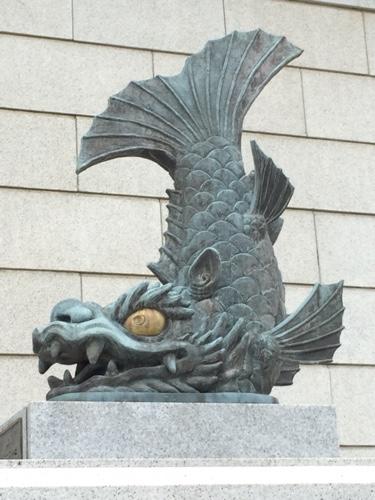
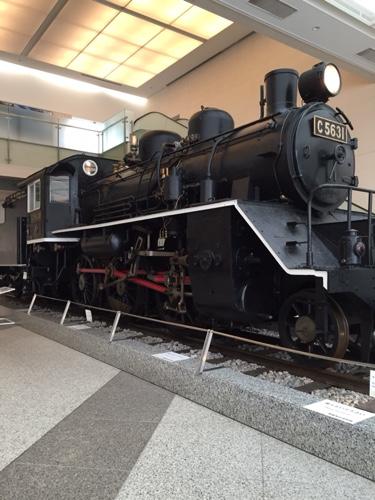 In the main lobby to the war museum is the train which operated on the Taimen Railway between Burma and Thailand during the Greater East Asia War. After the war, the train was used by the Thai before being recovered and returned to Japan (it was domestically made here originally) for the museum.
In the main lobby to the war museum is the train which operated on the Taimen Railway between Burma and Thailand during the Greater East Asia War. After the war, the train was used by the Thai before being recovered and returned to Japan (it was domestically made here originally) for the museum.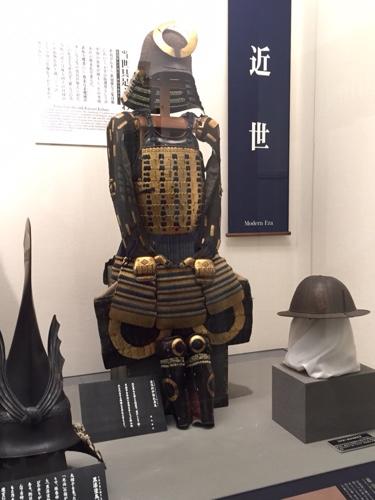 There are many fascinating armaments and objects on display, armour from 900 years ago worn by various famous warrior generalsnlike Minamoto no Yoshiie – it is hard to see in the photograph, but they are decorated with plum blossoms and butterflies and denote a person of high rank. Below is a picture of a Kaitan one man submarine torpedo that was piloted to hit an enemy ship. It contained 1.5 tonnes of high explosives in its bow and would instantaneously sink a ship – over a hundred people committed suicide in one of these Kaiten torpedos. I never heard of these before… the nautical equivalent of suicide airforce pilots.
There are many fascinating armaments and objects on display, armour from 900 years ago worn by various famous warrior generalsnlike Minamoto no Yoshiie – it is hard to see in the photograph, but they are decorated with plum blossoms and butterflies and denote a person of high rank. Below is a picture of a Kaitan one man submarine torpedo that was piloted to hit an enemy ship. It contained 1.5 tonnes of high explosives in its bow and would instantaneously sink a ship – over a hundred people committed suicide in one of these Kaiten torpedos. I never heard of these before… the nautical equivalent of suicide airforce pilots.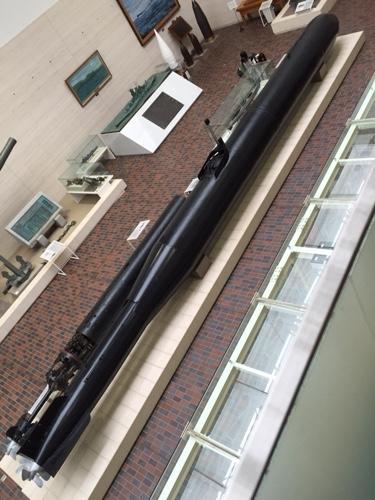
 The main Shrine of the Yaskuni shrine being built in 1882 had large scale repairs during he Showa era and the original roof was kept here for display. Below is a rising sun flag signed by prisoners of war during WWII who were all considered class A war criminals…
The main Shrine of the Yaskuni shrine being built in 1882 had large scale repairs during he Showa era and the original roof was kept here for display. Below is a rising sun flag signed by prisoners of war during WWII who were all considered class A war criminals…
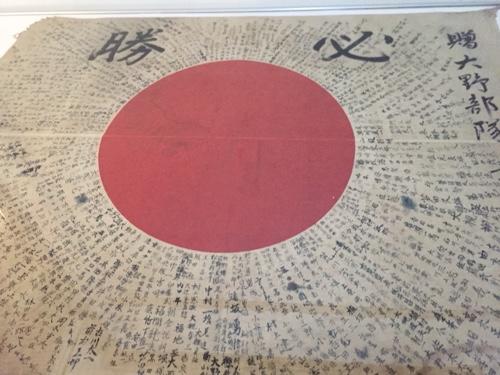
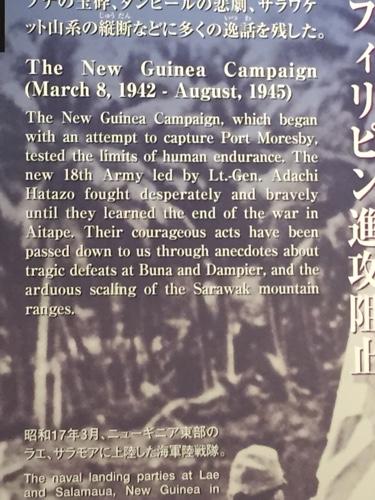 This plaque sums up the entire evolvement of the Japanese in Papua New Guinea… and that’s it. No mention of Milne Bay and the first major setback the Japanese army experienced in the Pacific, nothing. Also notably absent was ANY MENTION OF PEARL HARBOUR! It’s like it never happened. No shit – all the info leading up to Japan entering WWII is mind numbingly boring information of how Japan was relying on the US for natural resources like oil, copper etc., and how the US was pressuring Japan over their involvement in Indochina. By this read – Japan engaged in WWII because of trade sanctions that the US had unfairly imposed. That’s it.
This plaque sums up the entire evolvement of the Japanese in Papua New Guinea… and that’s it. No mention of Milne Bay and the first major setback the Japanese army experienced in the Pacific, nothing. Also notably absent was ANY MENTION OF PEARL HARBOUR! It’s like it never happened. No shit – all the info leading up to Japan entering WWII is mind numbingly boring information of how Japan was relying on the US for natural resources like oil, copper etc., and how the US was pressuring Japan over their involvement in Indochina. By this read – Japan engaged in WWII because of trade sanctions that the US had unfairly imposed. That’s it. 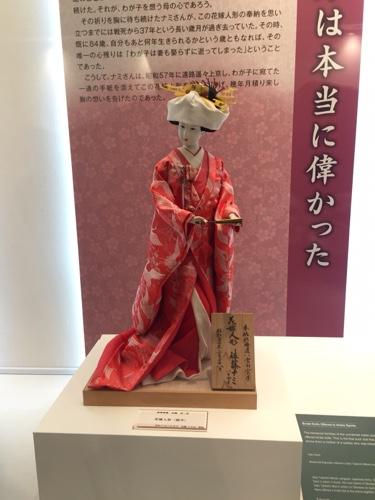 Further on there was an entire exhibition room full of these bridal dolls. The dolls were made by the bereaving families of unmarried nobles whose ‘spirits had died in battle’. The dolls were made by the mothers of soldiers and offered to the shrine, this one was the first, which appeared after a solder was killed in action in Okinawa.
Further on there was an entire exhibition room full of these bridal dolls. The dolls were made by the bereaving families of unmarried nobles whose ‘spirits had died in battle’. The dolls were made by the mothers of soldiers and offered to the shrine, this one was the first, which appeared after a solder was killed in action in Okinawa.
The War Muesum was very interesting and I would highly recommend people go check it out when in Tokyo – it is supposed to take about 90 minutes to complete the museum tour, but is much much quicker if you can’t read Japanese. 😛
After the war museum and memorial we went chasing an art gallery, but had been sent on a wild goose chase looking for some art at the Ota Memorial Museum of Art, which has turned into such a saga as to be worthy of a post all of its own – so I will get to that later as I do not have time to do it justice now.
We then made our way to Shibuya which has the enormous scramble crossing from hell. It was raining and there were umbrellas going everywhere, it was complete and total chaos and noisy and singing lamp posts and trucks with music playing and just mad house. Fun in a crazy kinda way. We went looking for a quiet bar to spend some time to recuperate. 🙂
We dropped Aunty Mary and Angel off and then headed to Shimbashi station to meet up with some friends from Mr K’s work. I was expecting a lovely night of talking taxi and limousine reform ahead… boy was I wrong! We went bar hopping in the Ginza district, stopping here for a glass of red, stopping there for a G&T, found an interesting restaurant we have no idea the name of but we called it ‘Dumpling City’ as there were hundreds of dumpling pictures outside the restaurant. Lots of amazing conversation… it turns out Mr K’s work counterpart from taxi and limousine in Victoria is married to the Minister for Education from the Victorian Government, so we had a wonderful evening of politics, travel, and Japanese absurdity.
 Many of these high rise buildings house tiny stair cases leading up and down to ‘mistress bars’ – these are bars set up for the cast off mistresses by their former lovers once they’ve had enough of their affairs! Bit of a weird custom if you ask me, but it’s quite the done thing. You have a mistress, as you do… and when you are sick of her, you no longer pay for her apartment and her lifestyle, so you set her up keeping her own little bar in which she can make a livelihood. It’s absurd and awesome.
Many of these high rise buildings house tiny stair cases leading up and down to ‘mistress bars’ – these are bars set up for the cast off mistresses by their former lovers once they’ve had enough of their affairs! Bit of a weird custom if you ask me, but it’s quite the done thing. You have a mistress, as you do… and when you are sick of her, you no longer pay for her apartment and her lifestyle, so you set her up keeping her own little bar in which she can make a livelihood. It’s absurd and awesome.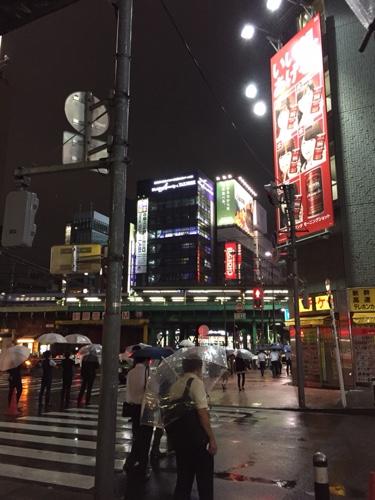 All round a great day but somewhat exhausting…. I’d like to say tomorrow is going to be lighter on and a bit easier – but there is so much to do!
All round a great day but somewhat exhausting…. I’d like to say tomorrow is going to be lighter on and a bit easier – but there is so much to do!
